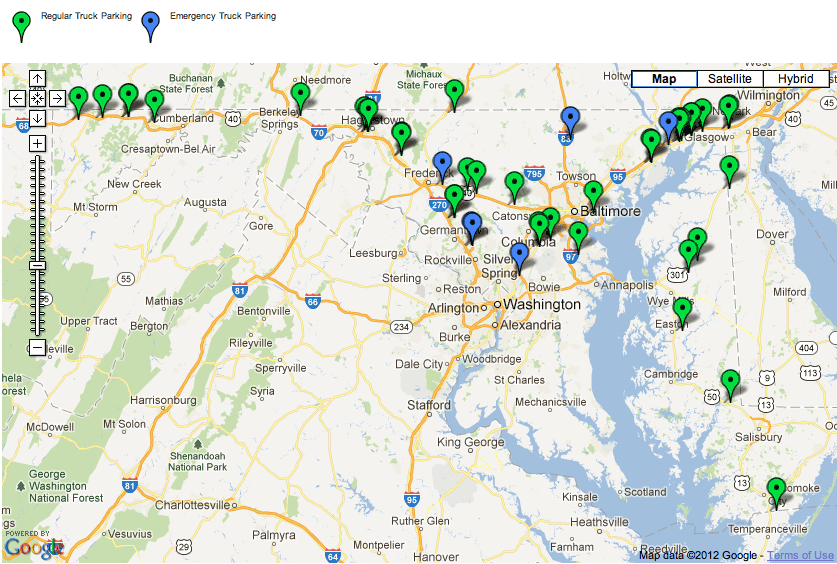Best Practices for Road Weather Management
Maryland DOT Emergency Truck Parking Portal
During inclement weather, and especially during severe snowstorms, drivers of commercial trucks are often in need of emergency parking areas or a safe haven to “ride out” the storm. As a result, the Maryland Department of Transportation (MDOT) in cooperation with the Maryland Motor Truck Association (MMTA) and the I-95 Corridor Coalition developed and implemented a program for emergency truck parking throughout the state of Maryland. The program includes the use of six (6) Park and Ride lots statewide to be used during heavy snow events as a safe haven for truckers. The development of a mobile application and web-based mapping to communicate the locations of all public facilities open for truck parking during emergency and non-emergency operations was also included as part of the program.
During the deployment process, the identification of emergency lots and enhanced use of available communication tools were proactive ways to alleviate future truck parking capacity issues similar to that experienced by the state of Maryland during the 2010-2011 winter season. To ensure safety on the state’s highways, it was determined that reliable and constant communication with truck drivers is imperative to ensuring efficient highway operations and maintenance during weather events. To accomplish this goal, Maryland developed the policy and set the process in motion by partnering with the state trucking association, police agencies, and local traffic and highway agencies.
The timeline from concept to project execution was less than two months, and truck drivers in Maryland now have designated places to stop during snowstorms. The six (6) Park and Ride lots across the state were selected as emergency lots for truck drivers traveling through Maryland by MDOT, Maryland Motor Truck Association, and the I-95 Corridor Coalition.
The total cost of the emergency truck parking application was approximately $100,000.
System Components: As mentioned above, the initiative includes the use of carefully selected Park and Ride lots, and mobile and Geographic Information System mapping applications. More information is available via Internet websites, and the page displaying emergency parking options for trucks can be viewed by going to the State Highway Administration (SHA) website.
System Operations: The goal of the system is to
help truckers going through Maryland make informed decisions during
snowstorms. A new “mobile app” is available to inform truck drivers
of the six (6) emergency lots, as well as other existing lots, to
be used for commercial truck parking. Users can download this
application to their phones, which will show a web-based map
indicating the location of regular truck parking options (shown in
green), and, on the same map, where emergency parking options are
located (shown in blue)—example in Figure MD-1.
There are two (2) emergency lots in Montgomery County, one (1) in
Harford County, one (1) in Baltimore County, one (1) in Frederick
County, and one (1) in Prince George's County. The Park and Ride
lots include facilities operated by the SHA and the Maryland
Transportation Authority (MDTA), which will be responsible for
removing the snow on the lots. The parking options can also
be viewed from an interactive map online or as a PDF document that
can be downloaded and printed.
Figure MD-1. Maryland’s emergency truck parking portal.
Transportation Outcome(s): During snowstorms of six (6) inches or more, tractor trailer drivers may use several commuter Park and Ride lots as a safe haven to “ride out” the storm instead of parking on highway ramps and shoulders, which present unsafe conditions for other highway users. This initiative provides an alternative for truckers traveling during heavy storms. The mobile application and web-based mapping tools provide the location of all truck parking areas available to truck drivers and company dispatchers, which facilitates preparedness when traveling in (and through) the state of Maryland.
Implementation Issues: One of the challenges faced during implementation was understanding the maintenance requirements of the public parking lots and determining whether truck parking would impede maintenance processes. The original list of potential emergency truck parking sites included 20 locations statewide, but facilities maintenance and geometric constraints reduced this number to six (6) sites to be used during the 2011–2012 winter season and thereafter. Another challenge was the inability to properly assess the results of the pilot program during the 2011–2012 winter season, which was largely due to the mild weather experienced in the Mid-Atlantic region.
Contact(s):
- Debbie Bowden, Freight and Economic Policy Analyst, Office of Freight and Multimodalism, Maryland Department of Transportation, 410-865-1094.
- Michael Baxter, Division Chief, Highway Information Services Division, Office of Planning and Preliminary Engineering, Maryland State Highway Administration, 410-545-5511.
Reference(s):
Keywords: Truck parking, emergency truck parking, truck parking communication.
previous | next